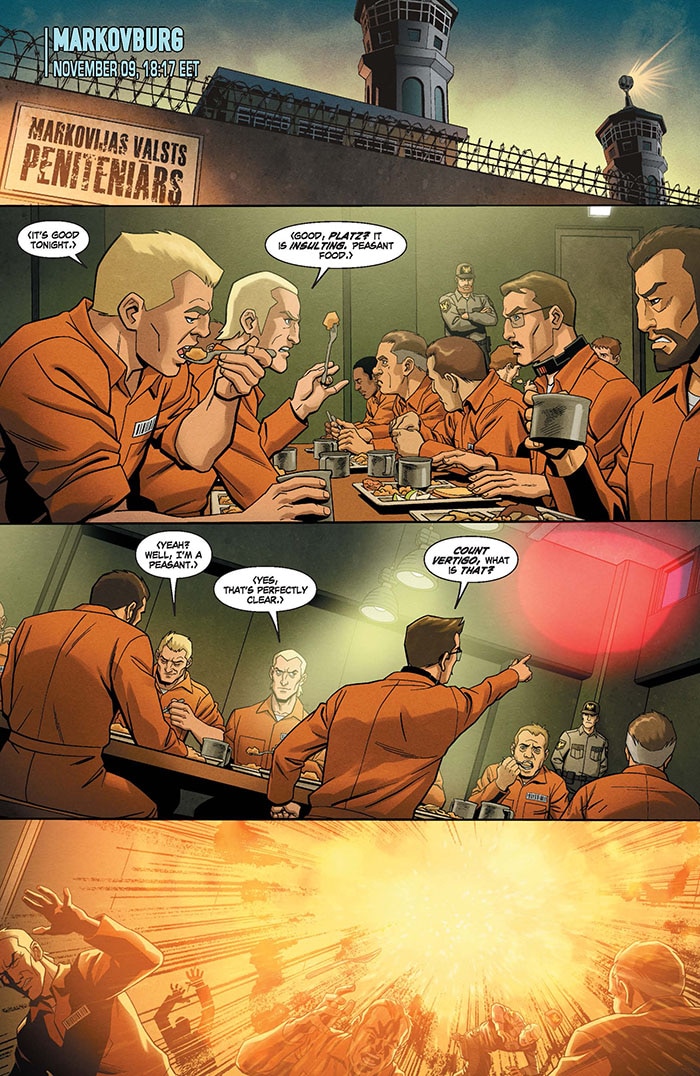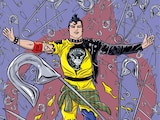Last week, Young Justice: Phantoms wrapped its boundary pushing season, but that doesn’t mean the adventure is over. If you’re hungry for more stories starring the heroes of Earth-16, a whole new chapter of the Young Justice saga kicks off today in Young Justice: Targets, a pivotal new comic book miniseries debuting exclusively on DC UNIVERSE INFINITE. This limited series picks up right where Young Justice: Phantoms left off, telling a new story that builds on what we just saw happen on the screen—and its bonafides are legit. Targets is written by Young Justice co-showrunner Greg Weisman and is penciled by Young Justice: Phantoms storyboard artist Christopher Jones. In other words, it doesn’t get more authentic than this. But to allay any remaining doubts you may have, we sat down for a chat with Weisman and Jones, who laid out everything you need to know about Young Justice: Targets.

Young Justice: Targets is the latest in a line of wonderful comic tie-ins for the series. The two of you worked together on the ongoing comic adaptation and the Young Justice: Outsiders DC UNIVERSE digital comic exclusive. How did you approach this versus how you approached the last few outings?
Greg Weisman: We were picking up where Young Justice: Phantoms left off. When we did the first 25 issues of Young Justice for DC, that was sort of fitting stories in between other stories. Here, we pitched a specific story about Perdita's abduction and what was behind it. They liked it at DC and (co-showrunner) Brandon Vietti liked it, and we went for it.
Christopher Jones: My process has actually changed quite a bit. I didn't start at the beginning of the original tie-in comic, I came in on issue #5. At that point, I was already a fan of the show, but I was not working on the show. Now, I'm coming to this after having spent a season doing storyboard revisions on Young Justice: Phantoms. And I'm drawing digitally with a lot more intimate knowledge of the art style and the various character designs and models. It's really exciting to get to revisit all this coming from this new place.
How did you develop the storyline for this limited series?
GW: Brandon Vietti and I used to have an entire wall of index cards of stories we hadn't gotten to yet. This main story came from some of those cards and the backup feature came from other cards. So, it's all part of the larger YJ tapestry. It's not like, “Oh, I need to create something because we're doing a comic book.” This is all stuff that we had in mind.
Not every story has a place on the timeline till we place it there, but this one we placed and it seemed like a good fit for the book. We wanted the book to pick up where this season left off, but also, at least in small ways, give all of our cast at least a moment. It’s the first set of comics we've done in quite some time, and we really wanted this to feel like it encompassed the larger YJ Earth-16 universe. This was a story where we felt we could do that. Where we could showcase a number of different characters in interesting ways.

Can you describe the emotional state of Earth-16’s heroes when this story begins?
GW: I think there's a lot of catharsis for our main cast, and even for a lot of the supporting cast around them. People are generally feeling pretty good. Beast Boy is on the mend. Conner and Megan successfully wed and no super-villains attacked during the ceremony. People are feeling pretty good, so this abduction of Perdita hits hard. There's a big response to it. Like, “We're not going through this again. We lost Connor for months. We thought we'd lost Rocket. We thought we lost Nightwing. We thought we lost a whole bunch of people on Bio-Ship. We thought Miss Martian got her heart pulled out of her chest. We thought all sorts of horrible things, and you know what? None of those are going to stop us. And now you grab Perdita? No, just no.”
I think they're starting in a fairly good place, and thus, the response to this is immediate and fairly intense.
CJ: One of the things I really like about the story is that it's not just heroes responding to a crisis, you're also seeing how they respond to it because of personal histories and relationships. To me, that's one of the defining characteristics of the show. It's as much about the relationships and how they're impacted over time by the adventures that are being had. And that's definitely present in the comic.
GW: Right. Perdita is one of their own.
As I was reading this issue, one thought crossed my mind: who was babysitting Wingman?
GW: Wingman is with Beast Boy in the first couple issues, but when and if Beast Boy goes someplace where he's not going to bring Wingman, I think just like with many pets, we leave them at home alone often (laughs). They don't require babysitters. They just require good housebreaking skills. If Garfield was going to be gone for a protracted period of time or thought he was, then he'd make arrangements. But also, Garfield lives at the Premiere Building and has many housemates, including Blue Devil and others. There's generally someone around. I also don't want to make it seem impossible for Beast Boy to leave his dog to go on a mission or just to go to dinner at a restaurant. He doesn't have to bring Wingman everywhere. He just likes to.

Can you describe your working relationship with one another?
GW: Chris has a lot more contempt for me than he used to (laughs). Chris and I go back a ways. We go all the way back to a Justice League story that I wrote and he drew back in what like the mid-90s or something like that (editor note: It’s JLA Showcase 80-Page Giant #1). And we became friends at Convergence in Minneapolis.
CJ: A convention I helped start that runs in Minnesota every year.
GW: Right. And then we worked together on Young Justice, some Gargoyles projects and some other things. He came aboard Young Justice for season four as staff on the show. Chris and I have similar sensibilities. We like going out for dinner and lunch. We like eating.
CJ: Greg's approach to this material and how he views the characters, as is expressed in the show in his collaboration with Brandon and the other creatives there, sits very well with mine. I mean, this is very close to the center of my strike zone of how I like to see these characters portrayed. So, it's a really comfortable fit for me and Greg writes very complete, tight scripts that are easy to follow. I just feel fortunate that he seems to write stuff where I know how I want to draw it. And he tells me he's reasonably happy with what I draw, so it seems to work out.
GW: You gotta lie. I mean, you gotta lie to keep the relationship working (laughs). That's a joke. I love Chris' stuff obviously. That's why I like working with him over and over.

Shout-out from the folks on the Whelmed: The Young Justice Files Discord server. Here is a question submitted from them: what are some of the different things that you consider when you're plotting a comic like this versus plotting an episode of the TV show?
GW: In some ways, the comics are more like traditional TV storytelling because there are act breaks in a comic at the end of each issue. In other words, if we're doing six issues, that means there are five act breaks in there. And so, you've got to build your story so it builds to some kind of climax or cliffhanger that keeps the audience coming back. Whereas one thing that Brandon and I are probably still adjusting to on the animated series is no act breaks. We've got 22 to 26 solid minutes of television, and there's no commercials. So how does that effect your traditional three act structure? It's something that we're still playing with and toying with on TV.
But getting back to the comics, you've got 15-20 pages, and then boom, it's done. And you want to make sure it's exciting enough and intriguing enough and compelling enough that at the end of that issue, people are like, “I’ve got to get issue #2!” And then the same thing for #3, #4, #5 and #6. Then hopefully, even at the end of #6, people are like, “I hope they do more!”
If we're doing our jobs right, that's what will happen. One thing I learned way back doing Gargoyles comics is that given a page count of about twenty pages or so per issue, that's about the equivalent in density of a third of a television episode. In essence, in a three act Young Justice episode, one issue is one of those three acts, so in order to do the equivalent density of one YJ episode, I need three issues. And thus, giving us a six-issue miniseries, like we have on Targets, is the equivalent of doing a two-part episode on Young Justice.
CJ: I don't disagree with any of it. It is interesting shifting gears from working on Young Justice in terms of storyboards for animation to going back to comics. It's a different subset of visual storytelling skills. It is absolutely still visual storytelling, but you're not planning for images that move. You are dividing up the visual geometry of the page. You are trying to figure out how to make things fit, including dialogue balloons, and have the action flow in the right direction across the page and all those things that are part of comic book art that most readers don't usually consider.
Most readers look at the art style and that's kind of where the analysis of the art ends. The actual art of creating a comics page is much more about logistical problem solving. There are also things you can do visually in a comic book that you can't do the same way in animation. In the first issue, we have a sequence where there are characters in three identical looking black vans. And on the page, we actually have panels that show the three interiors with arrows pointing to which vehicle they are in the establishing shot. I wanted the readers to understand these characters are in the car in front, these characters are in the car in the middle, and these characters are in the car at the back. And that's not how you would do it for animation. There's a lot of overlap, but you're exercising different muscles.
Young Justice: Targets #1 by Greg Weisman and Christopher Jones is now available to read exclusively at DC UNIVERSE INFINITE.
Discover more about Young Justice: Targets and the Young Justice animated series by reading Greg Weisman and Christopher Jones' answers to the questions asked by fans like you over in the DC Community.















